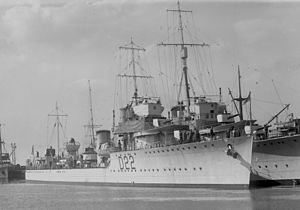HMAS Waterhen (D22)

HMAS Waterhen, with HMAS Stuart in background
|
|
| History | |
|---|---|
|
|
|
| Name: | Waterhen |
| Builder: | Palmers Shipbuilding and Iron Company |
| Laid down: | 3 July 1917 |
| Launched: | 26 March 1918 |
| Completed: | 17 July 1918 |
| Commissioned: | July 1918 |
| Decommissioned: | October 1933 |
| Fate: | Transferred to Royal Australian Navy |
|
|
|
| Name: | Waterhen |
| Commissioned: | 11 October 1933 |
| Decommissioned: | 9 October 1934 |
| Recommissioned: | 14 April 1936 |
| Decommissioned: | 1 June 1938 |
| Recommissioned: | 1 September 1939 |
| Nickname(s): | The Chook |
| Honours and awards: |
|
| Fate: | Sunk by dive bombers, 30 June 1941 |
| General characteristics | |
| Class and type: | W-class destroyer |
| Displacement: | 1,100 tons standard |
| Length: |
|
| Beam: | 29 ft 6 in (9.0 m) |
| Draught: | 13 ft 11 in (4.2 m) |
| Propulsion: | 3 × White=Forster boilers, 2 × Brown-Curtis turbines, 27,000 shp (20,000 kW), two shafts |
| Speed: | 34 knots (63 km/h; 39 mph) |
| Range: | 3,560 nautical miles (6,590 km; 4,100 mi) at 12 knots (22 km/h; 14 mph) |
| Complement: | 6 officers, 113 sailors |
| Armament: |
|
HMAS Waterhen (D22/I22) was a W-class destroyer that served in the Royal Navy (as HMS Waterhen (G28/D22)) and the Royal Australian Navy (RAN). Built during World War I, the destroyer was completed in mid 1918, and commissioned into the Royal Navy. In 1933, Waterhen and four other British ships were transferred to the RAN. The ship's early RAN career was uneventful, with periods spent decommissioned in reserve, but she was reactivated in September 1939, and deployed to the Mediterranean as part of the Australian destroyer force: the Scrap Iron Flotilla. During her time in the Mediterranean, Waterhen was involved in escort and patrol duties, performed shore bombardments, and participated in Allied evacuations from Greece and Crete. On 29 June 1941, while operating with the Tobruk Ferry Service, Waterhen was heavily damaged by Axis aircraft. Attempts to tow the ship to port were unsuccessful, and she sank on 30 June; the first RAN ship lost to combat in World War II.
Waterhen was a W-class destroyer constructed for the Royal Navy during World War I. The ship had a displacement of 1,100 tons at standard load, was 312 feet 1.25 inches (95.1294 m) in length overall and 300 feet (91 m) long between perpendiculars, had a beam of 29 feet 6.5 inches (9.004 m), and a maximum draught of 13 feet 11.125 inches (4.24498 m). Propulsion machinery consisted of three Yarrow boilers feeding two Brown-Curtis turbines, which provided 27,000 shaft horsepower (20,000 kW) to the two propeller shafts. Maximum designed speed was 34 knots (63 km/h; 39 mph).Waterhen had a range of 3,560 nautical miles (6,590 km; 4,100 mi) at 12 knots (22 km/h; 14 mph). The ship's company consisted of 6 officers and 113 sailors.
...
Wikipedia
